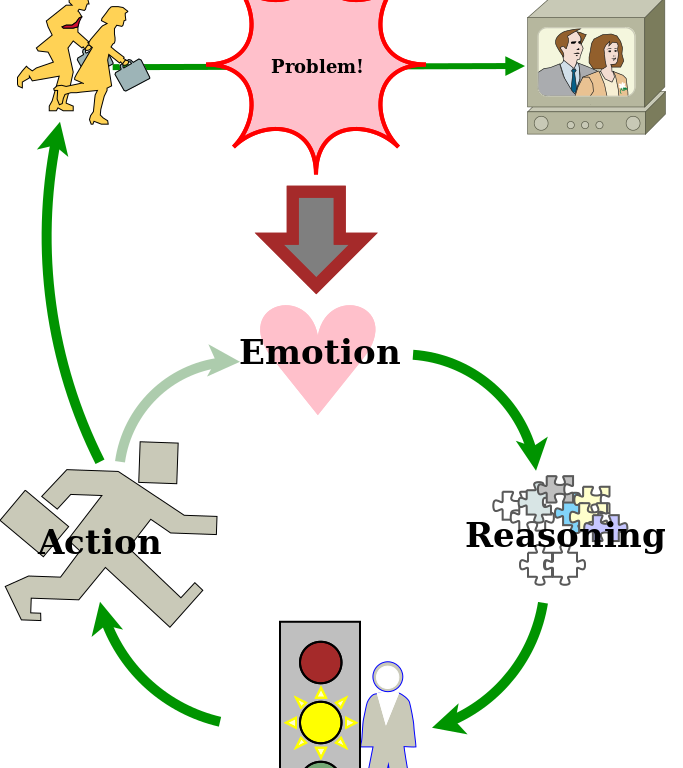Any story can be broken down into scenes and each scene works in the same way. You probably know that way very well – one or more persons want something and they encounter one or more problems stand between the character and their goal.
But did you know that scenes are like bricks? Bricks need mortar to hold them together. What holds a collection of scenes together is the scene-sequel.
The scene-sequel is made of the elements that guide us from one moment to the next. Let us take a look at how that works.
The scene and scene-sequel
As you know the scene opens with one or more people that want something. That something is called the goal. In this diagram, the goal is appearing on the TV.
The scene
While attempting to get to the goal, the characters encounter problems which they solve until they run into a critical problem and experience a setback. Maybe the casting agent said no. Maybe the studio is not hiring right now. Whatever the failure is it has blocked their way forward.
That failure ends the scene. But we do not start the next scene. Instead, we take a moment to get into the head of the characters.
Unless you are writing the closing chapter where the characters finally escape “peril” and achieve catharsis (resolution), all scenes end with a failure or disaster of some kind.
The scene-sequel
 Emotion
Emotion
The first thing we write about is the emotional response. How the character or characters feel about what has happened. If this is a romance story we will linger on this section. If it is an action adventure the section will be so small that you might even miss it.
Our would-be actors feel crushed. They are sad and their earlier enthusiasm becomes self-doubt.
Reasoning
But after the rush of emotions comes the cool-headed thinking. This is the reasoning stage. A good detective story might linger on this section a great deal. This is when the characters get creative in their thinking and make a plan.
Our duo decides to audition with a different studio as extras and work their way up the ladder.
Anticipation
Then comes anticipation. Anticipation is where the characters think about how others will see them, about what might happen next. In a tense thriller, we will linger here with the opposing sides each trying to anticipate the next move of the other. Likewise, a good romance might also linger here with the anticipation of the first kiss.
In our case, maybe they anticipate that their friends will see them as failures. So they agree to lie about getting the acting job. Of course, this will set up a situation where they will have further hard choices to make. If this is a comedy things will work out but if this is a drama…
Action
Finally, the person acts. That action is not entirely logical, preemptive, or emotional but a combination of all three. The readers can see why the character is acting as they are. They might not agree but they will understand the character’s motivation.
Action can lead us back into the next scene or – if there are more than one viewpoint characters – it can lead to further sequels as others react to the action. One of the staples of comedy is the piling up of mistaken interpretations of actions and misguided anticipation to have the characters is ever more ridiculous situations.
How each causes the next
Reasoning can and should cut across emotion but one should flow into the next. The strongest emotions inform the priorities for reasoning. Anticipation should flow naturally from the reasoning.
The kind-hearted spy realises that the one person who knows her secret is trapped in the airlock. She feels relieved that he cannot call for help but worried that he might die as she fears becoming a killer. She reasons that she should save the man in the airlock. It is the right thing to do and only she can do it. But then she anticipates that he will inform on her; if he raises the alarm she will be killed. Reluctantly she chooses to let him perish as the doors open and he is sucked into space. That choice will haunt her for some time to come.
While we may only show the viewpoint character going through this range of reactions, we need to show that the other characters that he or she interacts with may also be doing this too. In dramatic circles that cycle is called character motivation. A good storyteller makes the motivation clear.
How to use the scene cycle
If you are ever stuck trying to get characters from one scene to the next, it may be that you have forgotten to take them through the four steps of the scene-sequel.
Maybe the action you need next seems out of character. Let the character go through the process of emotion, reasoning, and anticipation that leads them to a critical departure from their normal behaviour.
Maybe you need the characters to try something unusual or different. Take them through the cycle and have them make some hard choices.
Whenever you are stuck and need to have characters take an apparent sharp right turn, the cycle is the process that keeps readers from seeing this as broken.
I will cover more about scene building infuture posts. For now, try applying it to a difficult scene and let me know how it workds out.

